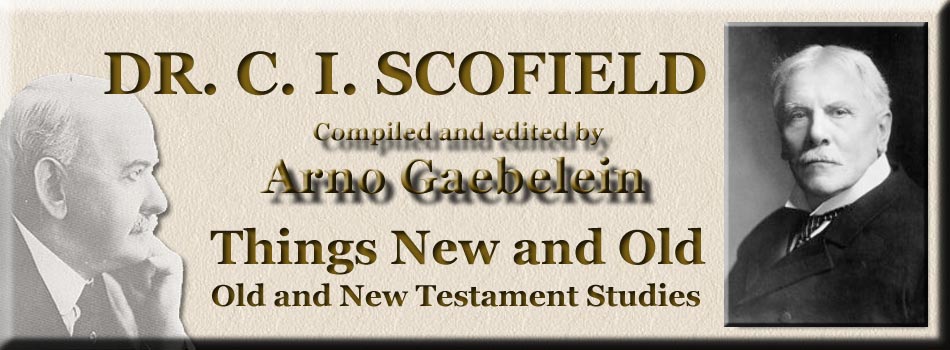
Things New and Old
By Cyrus Ingerson Scofield
Compiled and Edited By Arno Clement Gaebelein
THE BAPTISM AND TEMPTATION.(Matt, iii:13-iv:11.) I. The Analysis. The lesson is in four divisions:— 1. Jesus' Baptism by John (iii:13-15).—The fulfilling of ail righteousness by the sinless One, who, for Himself, needed no baptism of repentance, but who, in the very initial step in His public ministry, acts vicariously in behalf of sinners who deeply need that baptism. This is precisely the doctrine of Col. ii:12, which is not to be confused with Rom. vi:4, 5. Doubtless, also, Christ's baptism in Jordan, the river of judgment, was typical of His coming death (Luke xii:3o). Reject the notion often taught that this baptism was a priestly washing. Jesus Christ's high priestly work did not begin "on the earth" (Heb. viii:4), but when He was "lifted up from the earth" (John xii:32), and "offered Himself without spot to God" (Heb. ix:14) on the cross. 2. Jesus' Baptism by the Holy Spirit (iii:16, 17).—From this moment He becomes the Christ, which means the Anointed, the equivalent of the Hebrew Messiah. This anointing is unto His three-fold office of Prophet, Priest and King. He immediately enters upon His prophetic ministry; His priestly ministry began on the cross; His kingly work will begin at His appearing. The scene is also a complete manifestation of the Trinity. 3. Jesus Christ's Temptation (iv:1-10).—The tempter is Satan himself. It is the testing of the "last Adam,'' the "second man" (1 Cor. xv:45, 47)- 'The appeal was to His three-fold being—body, "command that these stones be made bread"; soul, "cast thyself down"; spirit, "all these things will I give thee." In each the core of the appeal was to Jesus Christ as man, to act from Himself, in independence of the Father. It should be noted that the quotations used are from Deuteronomy—the book especially singled out by the higher critics as a late forgery. Imagine two beings like the Son of God and Lucifer, both of whom knew the facts, seriously quoting from a writing that both knew to be spurious! 4. The Angelic Ministry of Jesus (iv:11).—It is important to note here that angels exercise a ministry of physical restoration and renewal (Luke xxii:43; cf. 1 Kings xix:5-8). II. The Heart of the Lesson. The central, vital truth of this lesson is not far to seek. Each of these first temptations of our Lord had one object— to seduce Him from the pathway marked out for Him as the Son of God on a mission to this world. The first would have taken Him from His appointed state of dependence on the Father for personal need. The second would have led Him beyond faith into a fanatical and presumptuous act for which He had no word of Scripture, though Satan endeavored to persuade Him that He had. Here lies one of our subtlest dangers. Every excess of fanatacism grounds itself on some misapplied passage of Scripture. Kingdom promises are put before believers who are members of Christ's body, not subjects of His millennial kingdom. Satan can quote Scripture, but Satan never applies it correctly. The third temptation was still addressed to the one object— to get our Lord out of His appointed path. Nothing is more certain than that the kingdoms of this world are to become ''the kingdoms of our Lord and of His Christ" (2 Sam. vii:8-14; Psa. ii; Jer. xxiii:5-8; Isa. ix:6, 7; Luke i:30-33; Acts xv:14-17), but between the Son of man as He stood that day in the wilderness of the temptation, and the throne of His father David, lay the cross of Calvary. Every one of these temptations come to fellow-sons and co-heirs with Jesus. The pathway of faith lies through testings which appeal to bodily needs; to fanaticism instead of faith, and to the avoidance of that suffering which for us, too, lies between conversion and the crown (Rom. viii:17).
|
|
 |
 |
|
|
|
-
Site Navigation
 Home
Home What's New
What's New Bible
Bible Photos
Photos Hiking
Hiking E-Books
E-Books Genealogy
Genealogy Profile
Free Plug-ins You May Need
Profile
Free Plug-ins You May Need
 Get Java
Get Java.png) Get Flash
Get Flash Get 7-Zip
Get 7-Zip Get Acrobat Reader
Get Acrobat Reader Get TheWORD
Get TheWORD